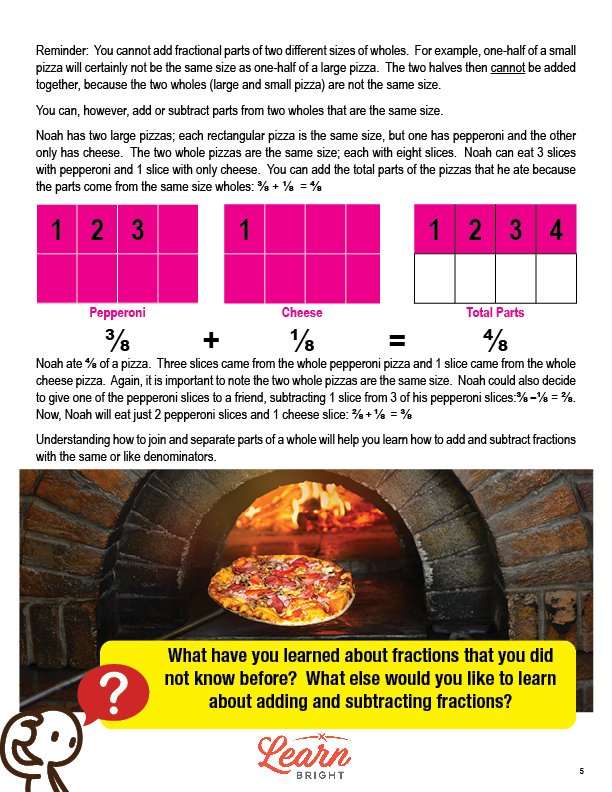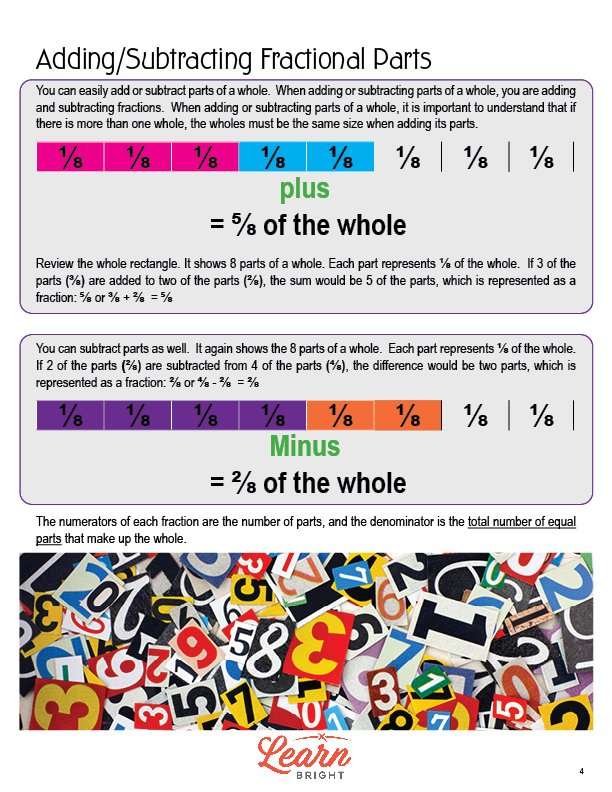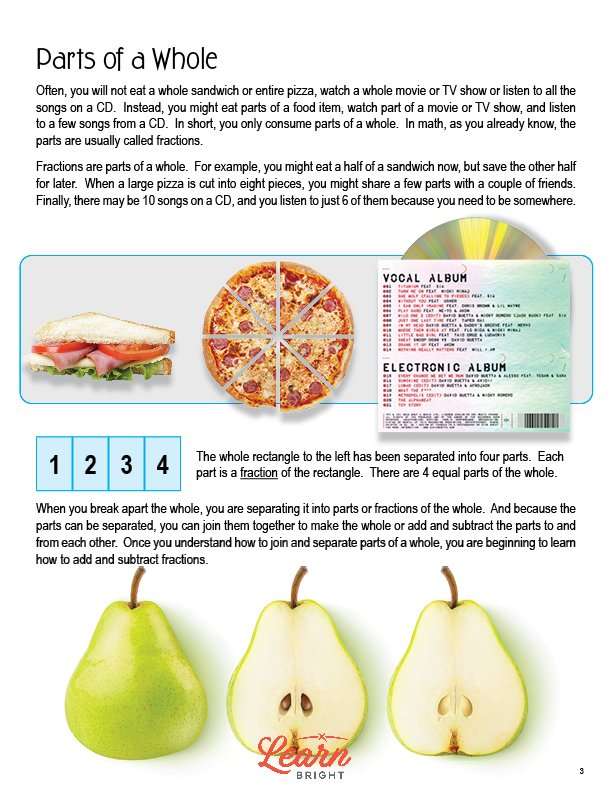Description
What our Understanding Addition/Subtraction of Fractions lesson plan includes
Lesson Objectives and Overview: Understanding Addition/Subtraction of Fractions teaches students about adding and subtracting fractions. At the end of the lesson, students will be able to explain how to add and subtract fractions with like denominators, including how two fractions refer to the same whole. This lesson is for students in 4th grade.
Classroom Procedure
Every lesson plan provides you with a classroom procedure page that outlines a step-by-step guide to follow. You do not have to follow the guide exactly. The guide helps you organize the lesson and details when to hand out worksheets. It also lists information in the blue box that you might find useful. You will find the lesson objectives, state standards, and number of class sessions the lesson should take to complete in this area. In addition, it describes the supplies you will need as well as what and how you need to prepare beforehand. The supplies you will need for this lesson are construction or poster paper, colored pencils, rulers, compasses, and the handouts. To prepare for this lesson ahead of time, you can gather the supplies, pair the students for the activity, and copy the handouts.
Options for Lesson
Included with this lesson is an “Options for Lesson” section that lists a number of suggestions for activities to add to the lesson or substitutions for the ones already in the lesson. To make things easier for you, you can create a rubric for the poster that students will create during the lesson activity. You can also have students vote for the best and most creative posters as a part of that activity. Another optional addition to the lesson is to have students write a creative story that includes fractions as characters. A helpful addition to the lesson could be to use hands-on manipulatives to help illustrate the concepts; you can also have students create their own manipulatives out of paper plates or cardboard. Finally, if you have more advanced students, you can have them add and subtract fractions with like denominators.
Teacher Notes
The teacher notes page includes a paragraph with additional guidelines and things to think about as you begin to plan your lesson. This page also includes lines that you can use to add your own notes as you’re preparing for this lesson.
UNDERSTANDING ADDITION/SUBTRACTION OF FRACTIONS LESSON PLAN CONTENT PAGES
Parts of a Whole
The Understanding Addition/Subtraction of Fractions lesson plan includes three pages of content. The lesson begins by pointing out that, sometimes, you will not finish something. You might eat part of a pizza or listen to part of a song. In math, we call parts of a whole fractions.
The lesson shows several examples, including a rectangle split into four parts. The four parts, when put together, equal the whole. When you break apart the whole, you are making it into parts or fractions of that whole. Parts can be separated, but they can also be joined together. It’s important to understand this concept in order to learn how to add and subtract fractions.
Adding/Subtracting Fractional Parts
It’s easy to add or subtract parts of a whole. When you do this, you are actually adding or subtracting fractions. If there’s more than one whole, they must be the same size to add their parts together. The lesson includes an example: a rectangle split into eight parts. Each part is 1/8th of the whole. If you add three parts (3/8) and two parts (2/8) together, you get 5/8, because it’s five of the parts.
You can also subtract parts. Using the same example of a rectangle with eight parts, each part is 1/8th of the whole. If you subtract two parts (2/8) from four parts (4/8), you get 2 parts, or 2/8.
For each fraction, the numerators are the number of parts and the denominator is the total number of equal parts that make up the whole. You can’t add fractional parts of two different sizes of wholes (fractions with different denominators). To visualize this, think about pizza. Half of a small pizza is different than half of a large pizza.
You can add or subtract parts from two wholes that are the same size. For example, you might have two large, rectangular pizzas that are the same size, one of which is cheese and one of which is pepperoni. Each has eight slices. You eat three slices of pepperoni and one cheese. To find out the total amount of pizza eaten, you just have to add the parts together: 3 (pepperoni) + 1 (cheese) = 4. You ate 4/8ths of a pizza.
If you understand how to join and take away parts of a whole, you can add and subtract fractions with the same or like denominators!
UNDERSTANDING ADDITION/SUBTRACTION OF FRACTIONS LESSON PLAN WORKSHEETS
The Understanding Addition/Subtraction of Fractions lesson plan includes three worksheets: an activity worksheet, a practice worksheet, and a homework assignment. You can refer to the guide on the classroom procedure page to determine when to hand out each worksheet.
CREATE A POSTER ACTIVITY WORKSHEET
Students will work with a partner to create a poster that shows three things: that parts of a whole are fraction, that the parts may be added together, and that the parts may be subtracted from each other. They can used drawings of different shapes (like squares or circles) or other things to illustrate each concept. They should include text that explains how to join or separate parts of a whole using adding or subtracting, and should add color to their poster and be creative with their design. Also, they should make their posters organized and neat, with straight lines and even circles. The aim of the poster is to help the viewer learn about adding and subtracting fractions. Once they’re done with their poster, they will display it in their classroom. The worksheet includes space for students to draw a rough draft of their poster.
Students may also work either alone or in larger groups for this activity.
UNDERSTANDING ADDITION/SUBTRACTION OF FRACTIONS PRACTICE WORKSHEET
For the practice worksheet, students will complete two short exercises. For the first, they will read statements and decide whether they are true or false. Next, for the second, they will use the large rectangle shown on the worksheet to answer 10 questions.
ADDITION AND SUBTRACTION SENTENCES HOMEWORK ASSIGNMENT
The homework assignment asks students to write addition or subtraction fraction sentences to show either the sum or difference of the shaded parts in the figures included on the worksheet. They will shade the rectangle to represent the sum or difference for each.
Worksheet Answer Keys
This lesson plan includes answer keys for the practice worksheet and the homework assignment. If you choose to administer the lesson pages to your students via PDF, you will need to save a new file that omits these pages. Otherwise, you can simply print out the applicable pages and keep these as reference for yourself when grading assignments.









